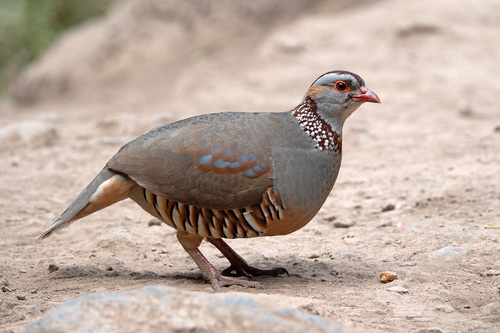
Barbary Partridge
The Barbary Partridge (*Alectoris barbara*) is a gamebird in the pheasant family (Phasianidae) native to North Africa and introduced to parts of Southern Europe. It plays a crucial role in its ecosystem as both a seed disperser and prey item for larger predators. This species is well-adapted to arid and semi-arid environments, exhibiting unique behaviors and physical characteristics that allow it to thrive in challenging landscapes. While not globally threatened, some localized populations face pressures from habitat loss and hunting.
33-36 cm
Length
46-49 cm
Wingspan
Least Concern
Conservation Status
Distribution
Native to North Africa, ranging from Morocco to Egypt and south to the Sahara Desert. Introduced populations exist in Gibraltar, Portugal, Spain (including the Canary Islands), and Sardinia.
Lifespan
Typically 3-5 years in the wild, but can be longer in captivity.
Barbary Partridge's Habitat
Habitat Types
Arid and semi-arid scrubland, Rocky hillsides, Open woodlands, Agricultural areas with hedgerows
Climate Zones
Mediterranean, Semi-arid, Arid
Adaptations
Tolerant of high temperatures and limited water availability. Their cryptic plumage provides excellent camouflage in rocky and scrubby terrain.
Variations
Several subspecies are recognized, differing slightly in plumage coloration and size. For example, *A. b. barbara* is the nominate subspecies found in much of North Africa, while *A. b. koenigi* is found in northwestern Africa.
Appearance
Breeding Plumage
No significant difference between breeding and non-breeding plumage.
Seasonal Feather Changes
Minimal seasonal variation.
Sex Based Plumage Differences
Males and females are very similar in appearance.
Notable Features
Grey-brown upperparts with bold chestnut and white barring on the flanks., Distinctive chestnut collar speckled with white., Grayish-blue face with a white throat patch., Reddish legs and bill.
Diet and Feeding
Primary Foods
Seeds, Grains, Leaves, Insects, Small invertebrates
Foraging Behavior
Forages on the ground, scratching and pecking for food. Often feeds in small groups, especially outside the breeding season.
Specializations
Strong legs and bill adapted for digging and uncovering seeds and invertebrates.
Seasonal Diet Variations
Diet shifts depending on availability. More insects are consumed during the breeding season when chicks require protein-rich food, while seeds and grains are more important in winter.
Behavior
Social Structure
Forms coveys (small flocks) outside the breeding season. During breeding, pairs become territorial.
Communication
A variety of calls, including a loud, distinctive 'chuck-chuck-chukar' call., Visual displays, such as puffing up feathers and wing-spreading.
Migration
Generally non-migratory, but may undertake short-distance movements in response to food availability or weather conditions.
Territorial or Group Behaviors
Territorial during the breeding season, defending nesting areas. Outside of breeding, forms coveys for foraging and protection.
Conservation
Threats
Habitat loss due to agriculture and urbanization, Hunting pressure in some regions, Pesticide use, Hybridization with released Red-legged Partridges
Protection Programs
Habitat restoration projects in some areas, Hunting regulations in some countries
Local National Laws
Protected under various national and regional laws in its range.
Population Trend
Stable
Population Estimates
Global population estimated to be in the millions, but precise numbers are difficult to obtain.
Interesting Facts
They are very fast runners.
Barbary Partridges prefer to run rather than fly when threatened, using their strong legs to escape predators.
They are known for their dust bathing.
Like many ground birds, they engage in dust bathing to help maintain their plumage and remove parasites.
The Barbary partridge has been introduced outside it's range
This introduction was for game purposes.
Faqs about Barbary Partridge
What is the difference between a Barbary Partridge and a Red-legged Partridge?
While both species are similar, the Barbary Partridge has a chestnut collar and a grayish-blue face, while the Red-legged Partridge has a black-bordered white throat and a black line extending through the eye.
Are Barbary Partridges good to eat?
Yes, they are a popular gamebird in many regions and are considered to have good-tasting meat.
Do Barbary Partridges fly?
They are capable of flight, but prefer to run. They typically only fly short distances when flushed or to escape immediate danger.
Copyright @ Nature Style Limited. All Rights Reserved.
 English
English